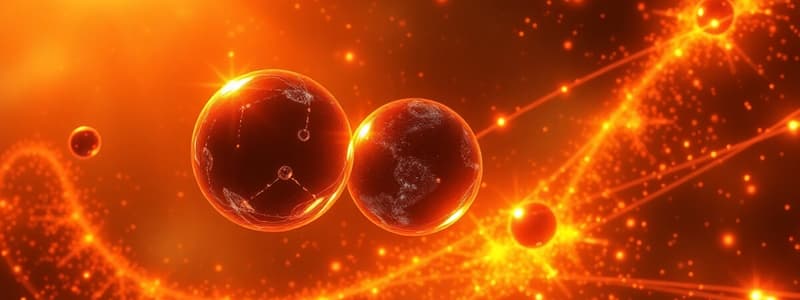Podcast
Questions and Answers
What key observation from Rutherford's gold foil experiment directly contradicted the 'plum pudding' model of the atom?
What key observation from Rutherford's gold foil experiment directly contradicted the 'plum pudding' model of the atom?
- Alpha particles were absorbed by the gold foil, indicating a dense structure.
- The gold foil emitted electrons when bombarded with alpha particles.
- Most alpha particles passed through the gold foil undeflected.
- A significant number of alpha particles were deflected at large angles. (correct)
Why did Niels Bohr utilize quantum physics in his atomic model, unlike the classical physics approach used previously?
Why did Niels Bohr utilize quantum physics in his atomic model, unlike the classical physics approach used previously?
- Classical physics could not explain the photoelectric effect observed in certain metals.
- Classical physics predicted that electrons orbiting the nucleus would continuously emit energy and spiral into it. (correct)
- Classical physics could not explain the emission spectra of different elements.
- Classical physics failed to account for the wave-particle duality of electrons.
In Thomson's 'plum pudding' model, how was the positive charge of an atom conceptualized?
In Thomson's 'plum pudding' model, how was the positive charge of an atom conceptualized?
- Concentrated in a central, dense nucleus.
- Distributed uniformly throughout the atom's volume. (correct)
- Existing as distinct, positively charged particles.
- Neutralized by an equal number of neutrons.
Rutherford's discovery of the proton was primarily based on observing the emission of hydrogen nuclei when alpha particles bombarded which elements?
Rutherford's discovery of the proton was primarily based on observing the emission of hydrogen nuclei when alpha particles bombarded which elements?
According to Bohr's model, how do electrons transition between different energy levels within an atom?
According to Bohr's model, how do electrons transition between different energy levels within an atom?
What was the most radical implication of Rutherford's 'solar system' model of the atom concerning the nature of matter?
What was the most radical implication of Rutherford's 'solar system' model of the atom concerning the nature of matter?
James Chadwick's discovery of the neutron in 1932 under Rutherford's guidance directly resolved a discrepancy in the understanding of:
James Chadwick's discovery of the neutron in 1932 under Rutherford's guidance directly resolved a discrepancy in the understanding of:
Prior to his professorship at Cambridge University, where did Rutherford hold a professorship in physics?
Prior to his professorship at Cambridge University, where did Rutherford hold a professorship in physics?
Rutherfordium, the synthetic element named in honor of Ernest Rutherford, is primarily recognized for its significance in which field of study?
Rutherfordium, the synthetic element named in honor of Ernest Rutherford, is primarily recognized for its significance in which field of study?
The shift from Thomson's 'plum pudding' model to Rutherford's nuclear model of the atom represented a paradigm shift primarily in our understanding of:
The shift from Thomson's 'plum pudding' model to Rutherford's nuclear model of the atom represented a paradigm shift primarily in our understanding of:
Flashcards
Bohr's Atomic Model
Bohr's Atomic Model
Proposed that electrons orbit the nucleus at fixed energy levels.
Quantum Physics
Quantum Physics
Branch of physics explaining the behavior of matter at atomic levels.
Plum Pudding Model
Plum Pudding Model
An early atomic model where electrons are embedded in a positive cloud.
Rutherford's Gold Foil Experiment
Rutherford's Gold Foil Experiment
Signup and view all the flashcards
Nucleus
Nucleus
Signup and view all the flashcards
Proton
Proton
Signup and view all the flashcards
Neutron
Neutron
Signup and view all the flashcards
Matter as Empty Space
Matter as Empty Space
Signup and view all the flashcards
Rutherfordium
Rutherfordium
Signup and view all the flashcards
Alpha Particles
Alpha Particles
Signup and view all the flashcards
Study Notes
Atomic Structure Development
- Atoms are not indestructible, they disintegrate
- Radiation is a product of disintegration
- Radioactive materials disintegrate at different rates, called half-lives
- Rutherford's model of the atom: a small, dense, positively charged nucleus with electrons orbiting around it
- Thomson's "plum pudding" model: electrons embedded in a positively charged sphere
- Rutherford's gold foil experiment led to the discovery of the nucleus
- Alpha particles were fired at a thin gold foil; some particles bounced back, suggesting a dense, positive nucleus
- Electrons orbit the nucleus at fixed energy levels, and change levels by absorbing/emitting energy packets
- Bohr's model incorporated quantum physics into the atomic structure
- Bohr realised classical physics couldn't explain Rutherford's model; used quantum physics.
- Elements can be bombarded with alpha particles and form other elements
- The existence of hydrogen nuclei was important as building blocks for other elements
- Proton, was found in hydrogen atoms
- The neutron, a particle with a neutral charge located in the nucleus.
- Rutherford identified the existence of protons
- Chadwick identified the neutron in 1932.
Studying That Suits You
Use AI to generate personalized quizzes and flashcards to suit your learning preferences.




